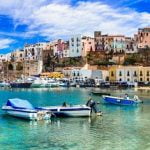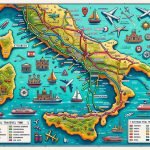Are you considering a trip to the beautiful island of Sicily, Italy? Whether you’re drawn to its rich history, stunning landscapes, or delicious cuisine, this Mediterranean gem has something for every traveler.
In this article, we will guide you on how to travel to Sicily Italy and provide you with essential tips for planning your trip. From transportation options to must-see attractions and local delicacies, we’ve got everything you need to make the most of your visit to Sicily.
Sicily is the largest island in the Mediterranean Sea and is located just off the “toe” of Italy’s “boot.” This diverse region boasts a unique blend of cultures, influenced by Greek, Roman, Arab, and Norman civilizations throughout its history. From ancient ruins and Baroque architecture to picturesque beaches and towering mountains, Sicily offers a myriad of experiences for travelers. Whether you’re an art enthusiast, history buff, or food lover, there’s something for everyone on this enchanting island.
When planning your trip to Sicily, it’s important to consider factors such as the best time to visit, transportation options, accommodations, must-see attractions, local cuisine, and navigating cultural customs. In this guide, we will delve into each of these aspects to help you make informed decisions and ensure a memorable experience in Sicily. So pack your bags and get ready for an unforgettable adventure in this captivating Italian destination.
Planning Your Trip to Sicily
When planning a trip to Sicily, it’s important to consider various factors that will enhance your travel experience. Here are some tips to help you plan your unforgettable journey to this beautiful Italian island:
1. Research and Itinerary:
Start by researching the best places to visit in Sicily and creating an itinerary that suits your interests. Whether you’re drawn to the historical landmarks of Palermo, the stunning beaches of Taormina, or the ancient Greek ruins of Agrigento, make sure to plan your schedule accordingly.
2. Accommodation Options:
Consider where you’d like to stay during your time in Sicily. The island offers a range of accommodation options, including luxury resorts, budget-friendly hotels, charming bed and breakfasts, and even rustic agriturismos. Look into different areas such as beachfront locations or countryside retreats to find the perfect place for your stay.
3. Transportation:
Once you’ve determined your destinations and accommodations, it’s essential to figure out how to travel to Sicily Italy and move around the island. You can choose from various transportation options including renting a car for flexibility, utilizing public buses and trains for cost-effectiveness, or booking tours for convenience.
By carefully planning your trip to Sicily and considering these aspects, you’ll be able to make the most of your time on this enchanting Mediterranean island.
Best Time to Visit Sicily
Sicily, the largest island in the Mediterranean Sea, boasts a rich history, stunning landscapes, and a warm climate. If you’re considering a trip to this beautiful destination, it’s essential to plan your visit during the best time of year to make the most of your experience.
The ideal time to visit Sicily is during the spring and fall seasons when the weather is mild, and the tourist crowds are thinner. From April to June and September to October, you can expect pleasant temperatures, blooming flowers, and fewer tourists compared to the peak summer months. This allows you to explore popular attractions without feeling overwhelmed by large crowds.
During these shoulder seasons, you can also take part in various cultural events and festivals that showcase Sicily’s traditions and customs. From religious processions to food festivals celebrating local cuisine, there’s always something happening on the island during these months.
Visiting Sicily in spring or fall not only provides more enjoyable weather but also ensures that you can fully appreciate its natural beauty and historical sites without feeling too hot or battling with hordes of tourists.
| Season | Temperature |
|---|---|
| Spring (April – June) | Mild; 60°F – 75°F |
| Fall (September – October) | Moderate; 65°F – 80°F |
In addition, traveling to Sicily during these times may also result in lower airfare prices and accommodation rates compared to the peak summer season. Overall, scheduling your trip during spring or fall will allow you to enjoy everything Sicily has to offer without having to deal with excessive heat or large crowds.
Getting to Sicily
Sicily, the largest island in the Mediterranean Sea, is a popular travel destination for those seeking both cultural enrichment and natural beauty. When considering how to travel to Sicily Italy, it is important to be aware of the various transportation options available for reaching this exquisite location.
One of the most convenient ways to travel to Sicily Italy is by air. The island is served by several airports, with the two main ones being Falcone-Borsellino Airport in Palermo and Fontanarossa Airport in Catania. These airports offer domestic and international flights, providing easy access to Sicily from major cities across Europe.
For those who prefer traveling by sea, there are also ferry services that connect Sicily with mainland Italy. This mode of transportation not only offers a scenic journey but also allows travelers to bring their vehicles along, providing flexibility for exploring the island at their own pace.
It is worth noting that once on the island, visitors can take advantage of an efficient network of public transportation including buses and trains to move around and explore different areas of Sicily. Renting a car is also a popular option for those who wish to have more freedom in their travels and fully experience all that Sicily has to offer.
| Transportation Option | Advantages |
|---|---|
| Air Travel | Convenient access from major cities across Europe |
| Ferry Services | Scenic journey and option to bring vehicles along |
| Public Transportation/Car Rental | Efficient way to move around the island / Freedom in travels |
Where to Stay in Sicily
When planning a trip to Sicily, one of the most important decisions you’ll need to make is where to stay. Fortunately, this Italian island offers a wide range of accommodations to suit every traveler’s preferences and budget. From luxurious resorts to cozy bed and breakfasts, Sicily has something for everyone.
Coastal Retreats
For those who want to bask in the sun and enjoy the stunning beaches of Sicily, staying at one of the many coastal retreats is a great option. Places like Taormina and Cefalù offer beautiful seaside resorts with breathtaking views of the Mediterranean Sea. Visitors can relax on pristine beaches, explore charming coastal towns, and indulge in delicious seafood at local restaurants.
Historic Towns and Cities
If you’re more interested in history and culture, consider staying in one of Sicily’s historic towns or cities. Palermo, the capital city, is a bustling metropolis with plenty of accommodation options ranging from boutique hotels to budget-friendly hostels. For a more authentic experience, opt for a stay in one of the island’s smaller towns such as Ragusa or Syracuse. These charming destinations offer quaint bed and breakfasts and guesthouses nestled within centuries-old buildings.
Countryside Villas
For travelers seeking peace and tranquility, the countryside of Sicily boasts an array of rustic villas and agriturismi (farm stays). Surrounded by rolling hills, vineyards, and olive groves, these accommodations provide a serene escape from the hustle and bustle of city life. Many also offer farm-to-table dining experiences, giving guests a taste of authentic Sicilian cuisine.
No matter where you choose to stay in Sicily, be sure to book your accommodations well in advance during peak travel seasons to ensure availability. Whether you prefer luxury by the coast or a peaceful retreat in the countryside, there’s no shortage of options when it comes to lodging on this enchanting island.
Must-See Attractions in Sicily
Sicily, Italy is a treasure trove of historical and cultural landmarks that will leave any traveler in awe. From ancient ruins to stunning coastal vistas, there are numerous must-see attractions that should be on every visitor’s itinerary.
Historical Landmarks
One of the most iconic historical attractions in Sicily is the Valley of the Temples in Agrigento. This archaeological site is home to some of the best-preserved ancient Greek temples outside of Greece itself. Another can’t-miss historical site is the Greek Theatre of Taormina, which offers breathtaking views of Mount Etna and the sea.
Natural Wonders
Sicily’s natural beauty is also a major draw for visitors. The Aeolian Islands, a volcanic archipelago off the northern coast of Sicily, are a UNESCO World Heritage Site and offer stunning landscapes and crystal-clear waters for snorkeling and swimming. Meanwhile, Mount Etna, Europe’s highest and most active volcano, provides fantastic hiking opportunities as well as panoramic views from its summit.
Art and Architecture
For those interested in art and architecture, a visit to the Cathedral of Monreale is a must. This Norman-Byzantine cathedral boasts intricate mosaics that cover every inch of its interior, depicting religious scenes with incredible detail. The baroque city of Noto has also been designated as a UNESCO World Heritage Site for its stunning architecture and artistic achievements.
Whether you’re drawn to history, nature, or art, Sicily has something to offer every traveler. With so many captivating attractions to explore, it’s no wonder why Sicily continues to enchant visitors from around the world.
Exploring Sicilian Cuisine and Local Delicacies
Sicily is not only famous for its stunning landscapes and rich history but also for its delectable cuisine. Exploring the local delicacies is a must for anyone visiting this beautiful island. Here are some Sicilian dishes and food experiences you should try:
1. Arancini: These deep-fried rice balls with a savory filling are a popular street food in Sicily. They come in various flavors such as ragu, cheese, and sometimes even pistachio.
2. Cannoli: A trip to Sicily would be incomplete without trying the iconic cannoli. These fried pastry tubes filled with sweet ricotta cheese and often garnished with candied fruits or chocolate are a dessert lover’s delight.
3. Granita: Perfect for cooling off on a hot day, granita is a semi-frozen dessert made from sugar, water, and various flavorings such as coffee, almond, or lemon. Enjoy it with a brioche for a typical Sicilian breakfast experience.
4. Seafood: Given its coastal location, Sicily boasts an abundance of fresh seafood dishes. From spaghetti ai frutti di mare to grilled swordfish, there are endless options to savor the flavors of the Mediterranean.
5. Street Markets: One of the best ways to experience Sicilian cuisine is by visiting the vibrant street markets where you can sample local cheeses, olives, cured meats, and freshly baked bread.
In addition to these culinary delights, don’t miss out on taking part in a cooking class or food tour to learn more about traditional Sicilian ingredients and cooking techniques.
Tips for Navigating Sicily’s Culture and Customs
Sicily, the largest island in the Mediterranean Sea, boasts a rich and diverse culture that is a blend of Greek, Roman, Arab, Norman, and Spanish influences. When traveling to Sicily Italy, it’s important to be mindful of the local customs and traditions in order to have a respectful and enjoyable experience. Whether you are visiting historic sites, enjoying the local cuisine or interacting with the friendly locals, understanding Sicilian culture will enhance your travel experience.
One of the first aspects of Sicilian culture to keep in mind is the concept of “dolce far niente,” which translates to “the sweetness of doing nothing.” This reflects the relaxed and laid-back attitude prevalent in Sicilian society. It’s not uncommon for shops and businesses to close for an afternoon siesta, so it’s essential to plan your sightseeing and dining accordingly.
Furthermore, when interacting with locals, it is customary to greet people with a warm “buongiorno” (good morning) or “buonasera” (good evening) when entering shops or restaurants. Additionally, it’s important to respect personal space and avoid speaking too loudly in public spaces. Sicilians also place great importance on mealtime rituals – savoring each course and engaging in leisurely conversations with dining companions is customary. It’s considered impolite to rush through a meal in Sicily.
In addition, traditional dress is still valued in some parts of Sicily, especially during religious festivals and events. Visitors should be respectful and modestly dressed when visiting churches or sacred sites. Understanding these cultural nuances will help visitors navigate the vibrant traditions of Sicily Italy with sensitivity and respect.
Conclusion
In conclusion, Sicily Italy is a destination that offers a rich tapestry of history, culture, and natural beauty. Planning your trip to Sicily may seem daunting at first, but with the right approach and information, you can create an unforgettable experience. From the ancient ruins of Agrigento to the bustling markets of Palermo, there is something for every type of traveler in this diverse and captivating island.
When considering how to travel to Sicily Italy, it’s important to note that the best time to visit is during the shoulder seasons of spring and fall when the weather is mild and the crowds are smaller. In terms of transportation options, flying into one of Sicily’s international airports or taking a ferry from mainland Italy are popular choices. Once on the island, renting a car can provide flexibility for exploring its diverse landscapes and hidden gems.
Where to stay in Sicily is another important consideration, with options ranging from luxury resorts to charming bed-and-breakfasts. And no trip would be complete without indulging in Sicilian cuisine and local delicacies – from savory arancini to sweet cannoli – as well as immersing oneself in the unique customs and traditions of Sicilian culture.
Embracing the beauty of Sicily Italy means embracing all that this enchanting island has to offer – from its stunning coastline to its vibrant cities and everything in between. So pack your bags, plan your trip wisely, and get ready for an adventure like no other in Sicily Italy.
Frequently Asked Questions
What’s the Best Way to Travel to Sicily?
The best way to travel to Sicily is by air. There are several airports on the island, including Palermo and Catania, which are well-connected to various European cities. Flying allows for a quick and convenient way to reach Sicily.
Where Do You Fly Into to Get to Sicily Italy?
To get to Sicily Italy, you can fly into one of the two main airports on the island: Falcone-Borsellino Airport in Palermo or Catania-Fontanarossa Airport in Catania. These airports have regular flights from major Italian cities and other European destinations.
How Long Is the Ferry Ride From Rome to Sicily?
The ferry ride from Rome to Sicily can take anywhere from 9 to 12 hours, depending on the route and the company. The ferries usually depart from Civitavecchia, a port city northwest of Rome, and arrive at either Palermo or Catania in Sicily. It’s a scenic but lengthy journey across the Tyrrhenian Sea.

I’m a passionate traveler, writer, and Italophile. My fascination with Italy’s history, art, and culture has led me on countless adventures across the Italian landscape. Through “I Live Italy,” I share my love for this extraordinary country and aims to inspire others to explore its boundless beauty.





